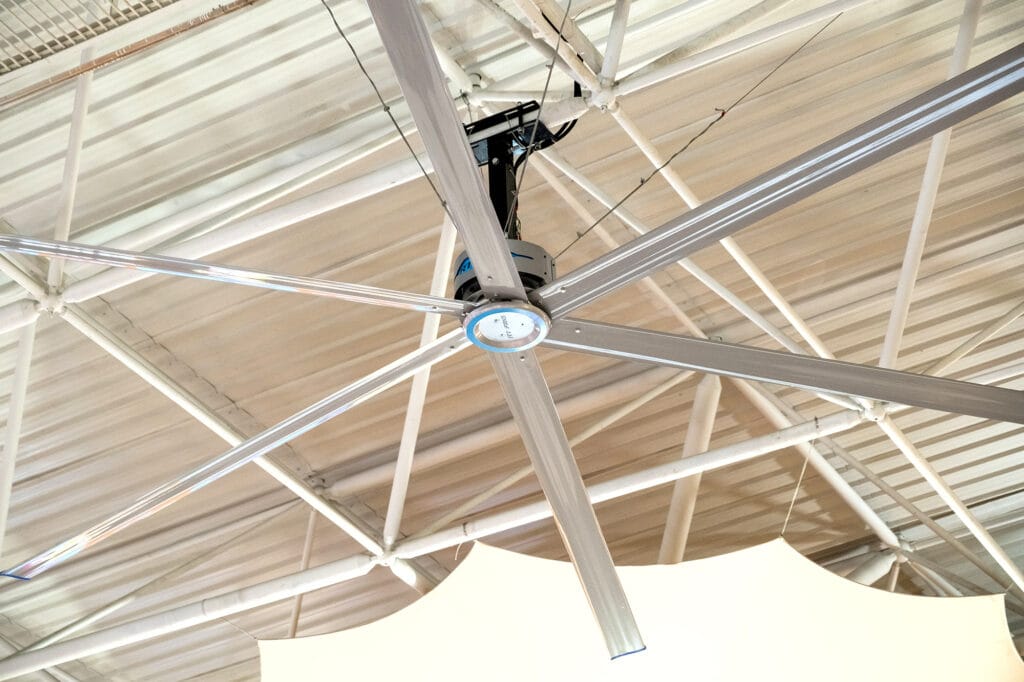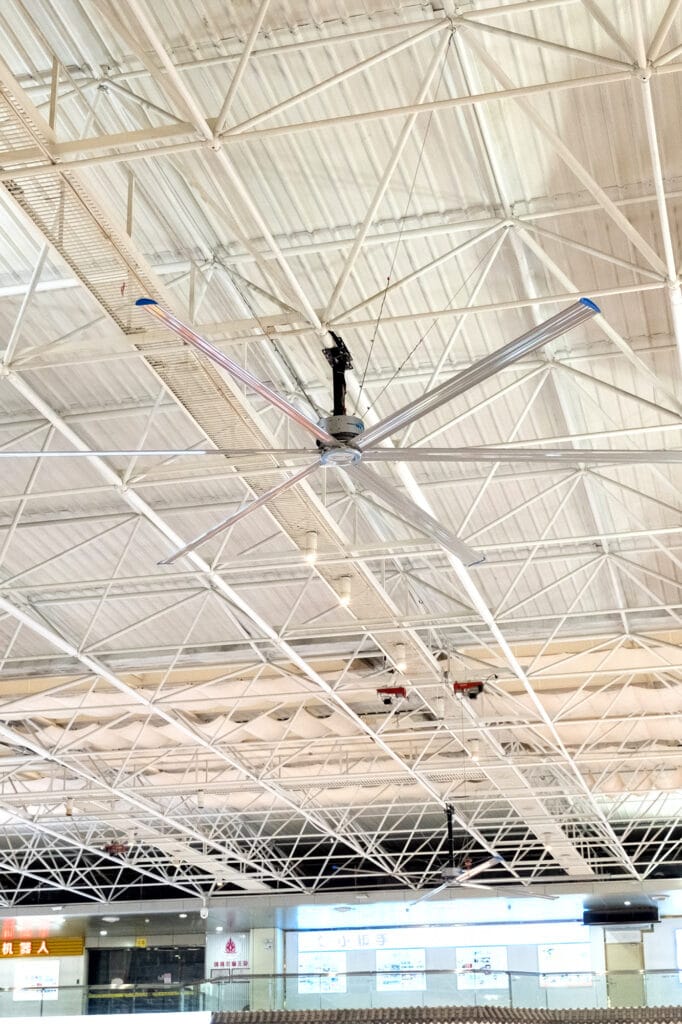Research indicates that low air quality kills student concentration by up to 15%- a serious problem in tight school halls where education occurs. Stifled air, CO2 concentration, and temperature imbalance provide conditions when students cannot focus their attention, which affects grades and health. Classroom industrial ceiling fans, often of the High-Volume Low-Speed (HVLS) type, have been shown to improve indoor air quality in schools and increase student focus and air movement. To school administrators and facility managers, school hall ventilation is an important aspect that would make schools productive learning environments.
RTFANS, with more than 20 years experience in ventilation solutions has revolutionized school halls with effective school hall ventilation plans. This article discusses the direct advantages of ceiling fans, the results of research and case studies, and useful suggestions to enhance air quality and student achievements.
The Immediate Impact of Poor Ventilation on Students
School halls that lack proper ventilation pose a direct threat to academic performance and will lead to poor environments. Excessive CO2 concentrations in congested areas impair thinking capacity and heat and humidity lead to fatigue. Ceiling fans (and HVLS in particular) provide a simple, low-cost solution as they enhance air circulation, minimize CO2, and stabilize temperatures. The following are the major problems and the way fans solve them.

Health Risks from Poor Air Quality
Low air movement in school halls cause an increase in CO2 levels, which, in most cases, surpass 1,000 ppm affecting the concentration and decision making. According to EPA studies, the quality of indoor air in schools can lower intellectual performance by 10-15 percent and trigger respiratory problems such as asthma by 20 percent. Dust, allergens and pathogens accumulate as well and are hazardous to health, particularly in stuffy areas during flu seasons.
HVLS fans propel up to 400,000 cubic feet of air mixing CO2 and polluting 15-20%. Two 16-foot HVLS fans can reduce CO2 in a 5,000-square-foot lecture hall and make the classroom and lecture hall environments healthier. This immediate advantage aids in student concentration and airflow, sick days decrease, and concentration increases.
Quick Fixes with Ceiling Fans
Ceiling fans offer immediate relief by pumping air and relieving heat stress. Their wind-chill effect cools spaces by 5-7 F, which means that HVACs will be used with less frequency. HVLS fans, unlike portable fans, occupy a wide space without creating noise disturbance (less than 35 dB), allowing lectures to go on uninterrupted. Fans can be integrated with the existing HVAC, thus reducing energy expenditure by 20-30%, which is one of the reasons why fans are an inexpensive solution when used in schools.
As one example, an auditorium in a high school with stuffy air installed three HVLS fans that enhanced air movement and led to a 25 percent decrease in complaints of discomfort. This low-tech solution illustrates how classroom industrial ceiling fans can turn classrooms around in a short period of time.
Evidence: How Poor Ventilation Hurts and Fans Help
There is extensive documentation of the relationship between air quality and student performance, and EPA and education research has been able to demonstrate that there is a connection between the two. We discuss the data and real-world examples that highlight why school halls need to be better ventilated.
EPA Data on Air Quality and Learning
According to the EPA, Indoor Air Quality Tools to Schools program, poor ventilation in schools causes a rise in CO2, volatile organic compounds (VOCs), and allergens resulting in lower test scores and greater absenteeism. One study concluded that students in well-ventilated classes scored 14% higher on cognitive activities compared to poorly-ventilated classes. Hot weather, which exceeds 77 F, also worsens fatigue, reducing the attention span by 10 percent.
Ceiling fans help curb these problems by destratifying air, mixing warm and cool layers so that they have the same temperatures. During winter they recycle warm air, saving 20-30 per cent of heating expenses. During summertime, they can set thermostats to 3-5 degrees higher and conserve 4% of energy per degree. This conforms to ASHRAE 62.1-ventilation requirements to promote healthy and more productive schools.

Case Studies: Real-World Improvements
- Urban High School Lecture Hall: The 6,000-square-foot hall had a problem with high CO2 readings during assemblies, which made students feel sleepy. The installation of two 18-foot HVLS fans cut the CO2 emissions by 15 percent and test results by 12 percent as students remained alert. There was a decrease of $3,000 in energy expenses.
- Middle School Cafeteria, Rural: Stuff and smell bothered lunch time. Three HVLS fans improved student concentration and air circulation, reducing humidity by 10 percent and improving attendance by 8 percent. The school saved 2,500 dollars a year on HVAC.
- Community College Auditorium: There was no balance between temperatures that caused students to complain. The conditions were stabilized with four HVLS fans that enhanced the focus and saved 25% of energy consumption (4,000/year). Faculty complained of increased interaction during lectures..
These examples demonstrate the way industrial classroom ceiling fans can provide quantifiable academic and operational returns.
Tips for Implementing Ceiling Fans in Schools
School administrators must consider the following tips to make the most out of ceiling fans:
- Evaluate Space Requirements: Determine the size and height of the ceiling in the hall. In spaces of 3,000 square feet plus and ceiling heights of 10 feet and above, use HVLS fans (12-20 feet diameter) to cover a maximum of 22,000 square feet.
- Select Quiet Fans: Different models under 35 dB will not interfere with classes. The low speed and low-noise features of HVLS fans make them the best.
- Make it Energy Saving: Use AMCA certified or ENERGY STAR fans so as to reduce HVAC expenses by 20-30%. Variable speed controls are used to optimize airflow.
- Planning Professional installation: Have certified contractors do the mounting to be sure of safe installation and HVAC integration to safety standards such as UL/ETL.
- Keep Clean: Clean blades once a year and inspect motors to guarantee a long life (15-20 years). This reduces idle time and expense.
To illustrate, one school district that retrofitted its halls with HVLS fans, adhering to the following tips, cut air quality by 20 percent and saved $10,000 per year in several facilities.
FAQ: Common Questions About Ceiling Fans in School Halls
- How do ceiling fans improve indoor air quality in schools?
HVLS fans reduce CO2 and pollutants by 15-20 percent, enhancing school indoor air quality and supporting student health and attention. - Can industrial ceiling fans help student concentration?
Yes, industrial classroom ceiling fans decrease heat stress and CO2 concentration in the classroom, increasing student focus and airflow, which improves cognitive performance by as much as 14 percent. - Are ceiling fans cost-effective for school hall ventilation?
With a payback period of 18-24 months, and cost (when compared to HVAC) reduced by 20-30 percent, HVLS fans are an economic solution to school hall ventilation.
Conclusion
Indoor air quality in schools is detrimental to student performance, with CO2 levels and heat lowering concentration to up to 15% of its usual level. A simple and economical answer to poor ventilation in schools and concentration and circulation in school halls is to install a industrial ceiling fan in the classroom, which enhances better ventilation and concentration by students. These fans can change the learning environment by reducing energy bills, improving air quality, and complying with standards such as ASHRAE, which facilitate academic achievement.School administrators must now take the initiative to better their halls. RTFANS is an expert company with 20+ years of experience in providing custom solutions of HVLS in schools. Call us now to improve the grades of your students and make your campus healthier and more efficient your school community deserves it.
